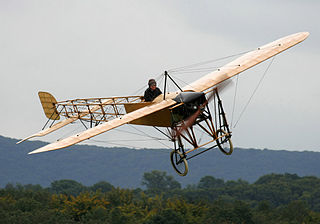
The Blériot XI is a French aircraft from the pioneer era of aviation. The first example was used by Louis Blériot to make the first flight across the English Channel in a heavier-than-air aircraft, on 25 July 1909. This is one of the most famous accomplishments of the pioneer era of aviation, and not only won Blériot a lasting place in history but also assured the future of his aircraft manufacturing business. The event caused a major reappraisal of the importance of aviation; the English newspaper The Daily Express led its story of the flight with the headline "Britain is no longer an Island."

The Borel Hydro-monoplane was a French seaplane produced in 1912.
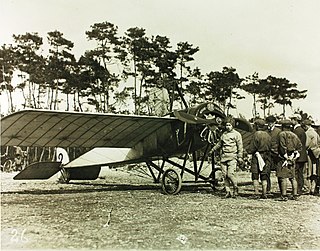
The Morane-Saulnier G was a two-seat sport and racing monoplane produced in France before the First World War. It was a development of the racing monoplanes designed by Léon Morane and Raymond Saulnier after leaving Borel and, like its predecessors, was a wire-braced, shoulder-wing monoplane. Construction was of fabric-covered wood throughout, except for the undercarriage struts which were of steel tube.

The Morane-Saulnier MoS-121, also known as the Morane-Saulnier MS.121, was a fighter prototype designed and produced by the French aircraft manufacturer Morane-Saulnier. It was the company's first fighter design after the First World War.
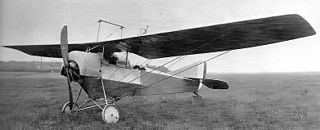
The R.E.P. 'Parasol' Type L was a military reconnaissance aircraft designed and produced in France by Robert Esnault-Pelterie in 1914.
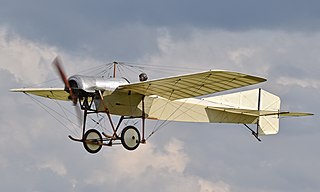
The Blackburn Type D, sometimes known as the Single Seat Monoplane, was built by Robert Blackburn at Leeds in 1912. It is a single-engine mid-wing monoplane. Restored shortly after the Second World War, it remains part of the Shuttleworth Collection and is the oldest British flying aeroplane.

The Dyott monoplane was a single-engined, single-seat mid-wing monoplane designed by George Miller Dyott for his own use as a sports and touring aircraft. It proved successful, making a six-month tour of the United States soon after its first flight in 1913.

The ASL Viking was a single-engined two seater biplane aircraft designed and built by Horatio Barber's Aeronautical Syndicate Ltd. at Hendon. It was first flown in January 1912.

The Morane-Saulnier MS.180 is a single engine parasol wing aerobatic trainer aircraft that was designed and produced by the French aircraft manufacturer Morane-Saulnier.

The Morane-Saulnier MS.341 was a single engine parasol wing training and touring aircraft built in France in the mid-1930s. It had two open cockpits in tandem and was sold to private owners, clubs and the Armée de l'Air.

The Blériot XIII was an experimental passenger-carrying aircraft built during 1910 by Recherches Aéronautique Louis Blériot. It is notable for setting a record for passenger carrying flights, and was probably intended as a developmental aircraft for the Blériot XXIV Limousine.

The Nieuport II was a mid-wing monoplane racing or sport aircraft built by the Société Anonyme des Établissements Nieuport between 1910 and 1914 and was noted for its high performance using a small twin-cylinder engine, and winning many races, primarily in France before being used as a trainer during World War I by French flying schools.

The Gabardini monoplane was a successful early monoplane constructed in Italy which made several notable flights, often carrying passengers, just before World War I. During the war, a number of lower-powered Gabardini monoplanes served as a training aircraft for the military.
The Gabardini biplane was an Italian single seat biplane, designed and built near the beginning of World War I. It was an advanced trainer and could be fitted with engines of output between about 40 to 80 kW.
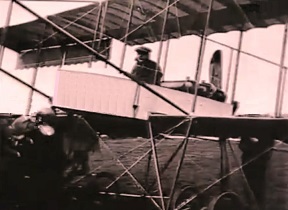
The Koolhoven Heidevogel was one of the first Dutch aircraft, an improvement of the popular Farman type.

The Van Meel Brikken was an early Dutch Farman type biplane. Three were built, one being the first Dutch military aircraft and another the first Dutch water-borne one. Two were used by the Dutch Army Aircraft Division as trainers.

The Hanriot D.I was a French monoplane racing aircraft, designed in France in 1912 and strongly influenced by Nieuport practice. Examples were built and raced both in France and the UK during 1912.
The Morane-Saulnier MS.300 and MS.301 were French parasol wing introductory trainer aircraft, first flown in 1930. They differed only in engine type. Neither reached production but were developed into two similar trainers, the MS.230 and MS.315, which were made in large numbers.

The Morane-Saulnier MS.221 was a French fighter aircraft, built in 1928 to compete for a government contract in the "Jockey" programme. Two were built, one of which was progressively modified to increase its speed, but in 1930 the light fighter concept was abandoned.

The Morane-Borel military monoplane was an unsuccessful French single-engine, multi-seat prototype aircraft built in 1911 for the Reims Military Aviation Competition hosted by the French Army. The aircraft only met one of the requirements and was eliminated from the competition.


















